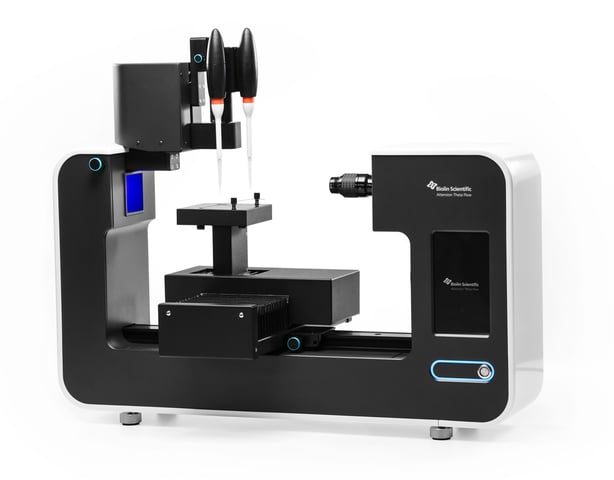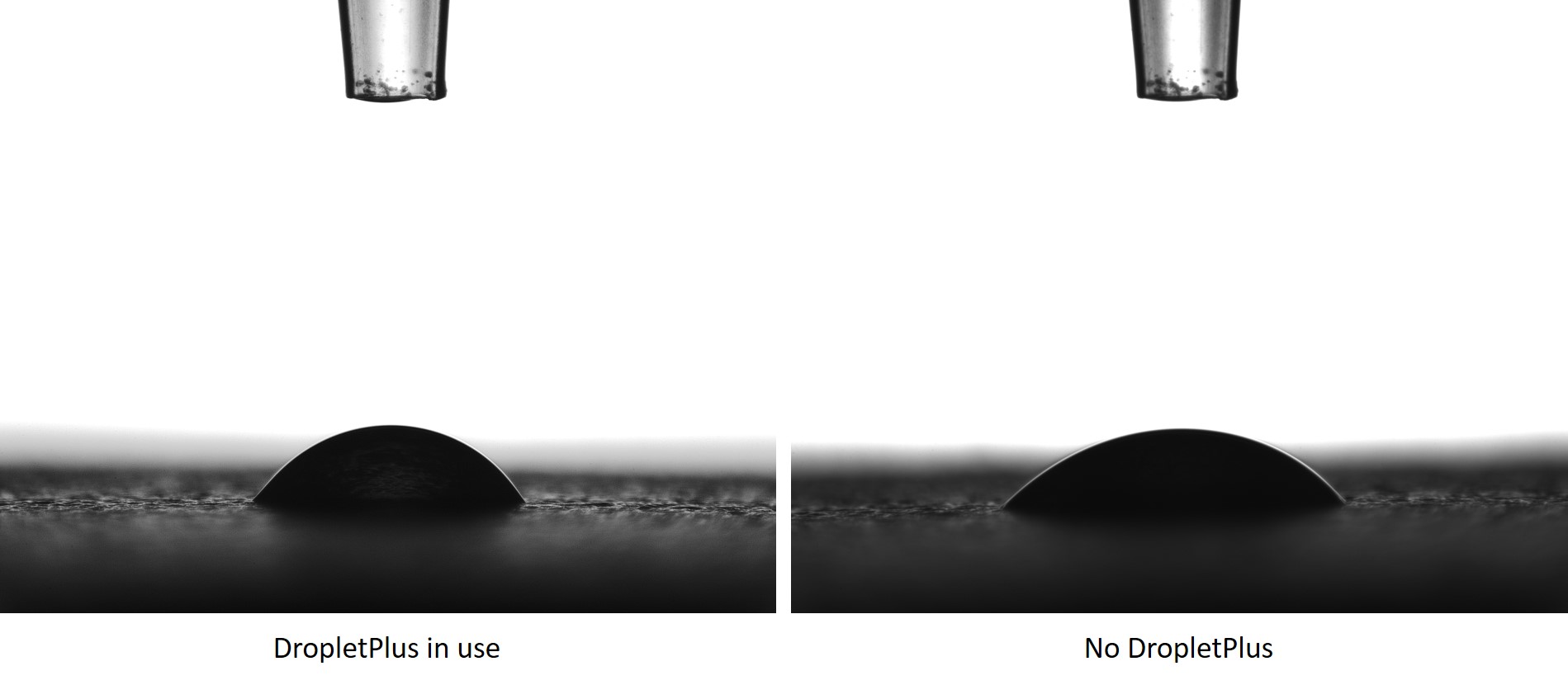
Theta Flow is the new Attension premium optical tensiometer. It has automation at an all-time high, accuracy not seen before, and remarkable simplicity and ease of use. Together these features make it the most user-independent contact angle meter.
Automatic droplet creation, automatic droplet placement on the sample, and automatic movement of the sample stage are typical characteristics of a premium contact angle meter. These features enable fully automated measurement of key parameters like contact angle, surface free energy (SFE), surface tension, and interfacial tension. However, as an optical analytical system, these alone won’t ensure full user-independency.
The sharp focusing of the image is essential in creating accurate results. This is a task typically done manually by the user and since the depth of view is very small when looking at small droplets, the user needs to be adequately experienced to perform the task successfully. Theta Flow has an advanced autofocus feature that can detect the droplet and needle in the image and keep their focus sharp. This eliminates the user-dependency in all measurements but is particularly useful in situations where the focus may change during the measurement or if it is otherwise difficult to set correctly. Examples include contact angle measurements on heterogeneous surfaces where the droplet may spread out of focus during measurement as well as dynamic contact angle measurements where the droplet is also prone to spreading out of focus. Autofocus feature can track the droplets even in these kinds of complex situations without user interference. Here is an example video of a dynamic contact angle measurement where the droplet focus is being followed through the measurement when its focus point changes.
Once the images have been recorded, one of the most error-prone parts of the measurement process begins; the analysis. The contact angle changes during the measurement due to spreading, evaporation, pinning, and other similar effects. Out of the different contact angle readings obtained at different time points, what should be the final result?
One option is to use a simple setup where the contact angle is always taken at a specific time, or as an average within a certain time frame. The weakness of this method is that the time frame is highly sample-dependent, and a fixed time won’t work for different samples.
A better way is to look at the full contact angle versus time data available and based on that, determine when the contact angle has stabilized. Theta Flow does this automatically and determines the optimal contact angle value based on all the data available. The contact angle value is then automatically fed into surface free energy calculation for automated SFE results. Similarly, also advancing and receding contact angle values can be automatically determined with Theta Flow with no user interference.
Many contact angle meters feature high theoretical resolutions and accuracies. These accuracies are typically unreachable due to numerous error sources not taken properly into account. Theta Flow has a series of features targeted to overcome these error sources and to provide highly accurate results.
Typically, the biggest source of uncertainty in a contact angle measurement is the droplet fitting. To fit the droplet, it is essential to find correctly the baseline, i.e. the line where the droplet meets the solid sample. Often setting the baseline is done manually, requiring considerable experience and know-how by the user. In more sophisticated systems, the baseline is set automatically by the system. However, the automatic baseline is also highly dependent on the visibility of the baseline in the image. To improve the visibility, the camera in many cases should be tilted downwards approximately two degrees to improve baseline visibility. Unlike traditional contact angle meters, in Theta Flow the camera tilt angle is electronically recorded and saved together with the measurement results. This will ensure high traceability and accuracy of the results. Theta Flow will notify the user in case the camera tilt angle isn’t set according to the value desired by the user.
Likewise, it’s important to make sure the camera is level before doing surface tension or interfacial tension measurements. Looking at the pendant droplet from an inclined angle will cause a significant error on the results which can be in the range of 0.5% per one degree inclined. Similarly, the system levelness is tracked with integrated sensors in Theta Flow. This will ensure the system itself containing the camera will be level as otherwise, the system tilt will have a similar effect on the results as having the camera tilted unwillingly.
To make the baseline as well visible as possible, Theta Flow features a set of baseline view-improving algorithms called DropletPlus. DropletPlus increases the contrast and the sharpness of the baseline to maximize the visibility and therefore to assist the automatic baseline and drop shape analysis. Here are example pictures on the surface with DropletPlus on and off to show the difference in baseline visibility in a more challenging sample.

One factor often overlooked in contact angle measurements are the ambient measurement conditions. While ambient temperature has been shown to have typically an effect of approximately -0.1⁰ per ⁰C change. [1] Moreover, the effect of humidity is typically even more major with the initial wetting changing potentially more than 5 degrees and the dynamic wetting being strongly affected by the ambient humidity level. [2] For these reasons, many international standards define the measurement conditions for tensiometry measurements. For example, ISO 19403 has strict limits on the measurement temperature and humidity. [3]
Theta Flow has integrated ambient temperature and relative humidity sensors that will record these values as a part of measurement results. This ensures a high level of traceability when the measurement conditions can be revisited later on the measurement data.
Finally, especially in applications where extremely low wetting is measured, the resolution of the camera is particularly important for measurement accuracy. [4] For these superhydrophobic surfaces, each pixel can mean an error of several degrees. Theta Flow has a 5 MP resolution camera (2592 x 2048 px) which, compared to typical cameras, will reduce this error in the range of 50%. The same camera can also record with more than 3400 frames per second speed in applications where extremely fast wetting and adsorption happen.
A feature that hasn’t been designed to be easily accessible to users is a feature that won’t be used and only the features used will increase the user-independency and accuracy of the measurement while reducing the operator learning curve to a minimum.
Theta Flow uses the OneAttension software that has been designed as graphical and intuitive as possible. The automatic results and readymade measurement settings facilitate getting the most out of Theta Flow. OneAttension also controls the disposable pipette tip dispensers that can be used to eliminate the need for any liquid cleaning.
As a special tool to further optimize setting up an experiment, Theta Flow has an integrated touch display that facilitates typical measurement preparation steps. Actions like filling the disposable tip dispenser and placing the sample onto the system are greatly facilitated by being able to control the automated devices on the display. The display also has a graphical interface for leveling the instruments using the electronic level indicator sensors. The display also shows important measurement parameter data like camera tilt angle and measurement temperature so that the user can see with one glimpse whether the measurement conditions have been set correctly.
Theta Flow incorporates many features and improvements that facilitate user-independent operation and highly reliable results. Building onto the award-winning Theta Flex quality, Theta Flow is a combination and high performance and practical high quality.
If you would like to hear more about how contact angle measurements and especially Theta Flow can be utilized for quality control, register to a webinar through the link below.
[1] J.D.Bernardin, I. Mudawar, C.B. Walsh ,and E. I. Franses, “Contact angle temperature dependence for water droplet on practical aluminum surfaces”, International Journal of Heat and Mass Transfer, 40 (1997) 1017.
[2] V.H. Chhasatio, A. S. Joshi, and Y.Sun, “Effect of relative humidity on contact angle and particle deposition morphology of an evaporating colloidal drop”, Applied Physics Letters 97 (2010) 231909.
[3] ISO 19403 https://www.iso.org/standard/64808.html
[4] M. Vuckovac, M. Latikka, K. Liu, T.Huhtamäki, and R. H. A. Ras, “Uncertainties in contact angle goniometry”, Soft Matter 15 (2019) 7089.
Discover why contact angle is essential for adhesion, coatings, and quality control. Learn how surface wettability impacts product performance.
Discover why PFAS-free coatings are needed, the challenges they present, and key strategies for developing high-performance alternatives.
At the heart of droplet formation are two key molecular forces: cohesion and adhesion.
Contact angle measurements provide a golden standard for evaluation of surface properties for quality control.
Contact angle is the angle a droplet forms in contact with a solid surface. Thermodynamically, it is a balance between cohesive and adhesive forces.
This blog post discusses the importance of adhesion in the lithography process and how to predict adhesion with contact angle measurements.
HMDS is used to render the surface of silicon more hydrophobic and thus to match better with the chemistry of the photoresist.
This blog post explains the concept of RCA cleaning and it's relation to contact angle.
Contact angle measurements can be used to evaluate the cleanliness of silicon wafers.
Jyrki Korpela is the Global Product Manager for Attension and KSV NIMA. He has a background in biomaterials from Aalto University and is constantly looking for ways to make the life of customers easier and their results better. He’s excited about working at the frontiers of science and progress
